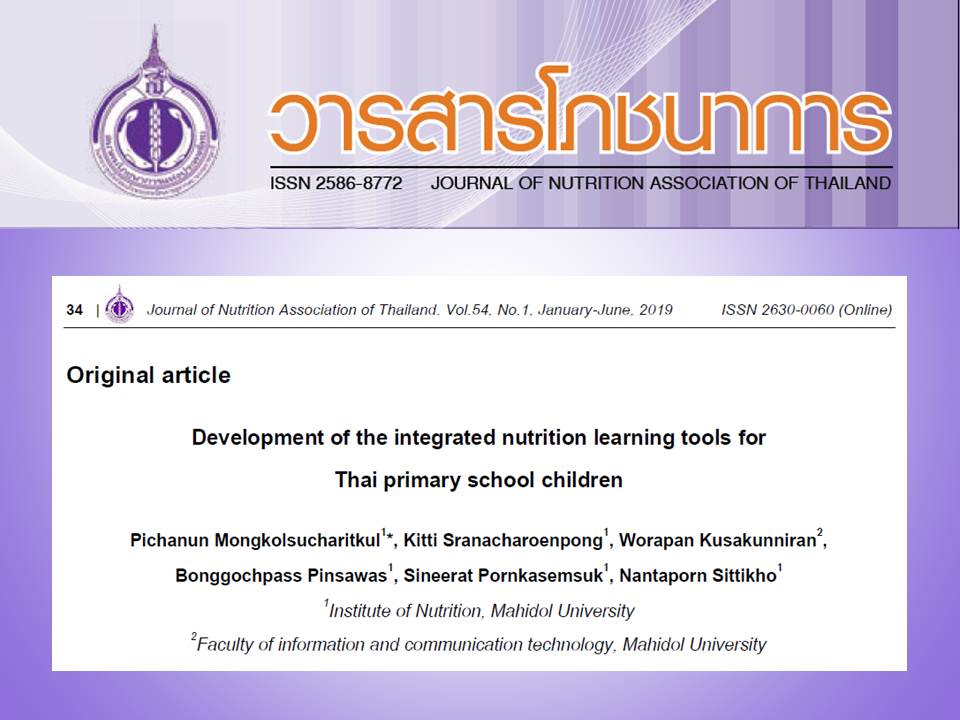Development of the Integrated Nutrition Learning Tools for Thai Primary School Children
Keywords:
Childhood obesity, Nutrition education, Integrated learning, Childhood obesity, Nutrition education, Integrated learningAbstract
The prevalence of childhood obesity is increasing over time in Thailand. Nutrition education is one important nutrition strategy aimed at childhood obesity prevention. This research study was aimed to develop the integrated nutrition learning tools that teachers can adopt to provide nutrition knowledge for primary school students (grade 1-3). The research process was to develop and validate nutrition learning tool. The nutrition content, which consisted of curriculum and lesson plan, computer-assisted instruction (CAI), worksheet and teaching guideline manual, were developed using principle of STEM Education. The curriculum was divided into 3 modules which were integrated into 3 subjects: Health Education, Mathematics, and English. Nutrition contents in Module 1 contained food-based dietary guidelines, nutrition flag, and five food groups. Module 2 was about eating less sweet, fat, and salt. The contents in Module 3 covered nutrition labelling, Guideline Daily Amount (GDA), and healthier choice logo. Each module covered 4 weeks. One lesson took 15 minutes per week for each subject. The nutrition tool was designed based on Massive Open Online Course (MOOC) instructional design model as learning process cooperates with different learning approaches. The content validity index (CVI) of tools and questionnaires, which included nutrition knowledge, attitude and food consumption behaviors of children, was calculated. Results showed that the CVI value of nutrition tools was 0.98, and that of questionnaires was 0.97 which were acceptable. Future studies are needed to evaluate the outcomes of nutrition literacy as well as the change in food consumption behaviors among primary school children implemented by this nutrition tool.
References
Department of Health: Ministry of Public Health. The annual report of the Department of Health in 2014. Bangkok: Ministry of Public Health; 2014.
Biro FM, Wien M. Childhood obesity and adult morbidities. Am J Clin Nutr. 2010;91(5):1499S-505S.
Steinbeck K. Childhood Obesity: Consequences and Complications. Clinical Obesity in Adults and Children: Wiley-Blackwell; 2010.
Choudhary AK, Donnelly LF, Racadio JM, Strife JL. Diseases Associated with Childhood Obesity. Am J Roentgenol. 2007;188(4):1118-30.
National Center for Chronic Disease Prevention and Health Promotion. Childhood Obesity Causes & Consequences. 2015. [cited 2016 Apr 7]. Available from:
https://www.cdc.gov/obesity/childhood/causes.html
National Health Examination Survey Office. The report of dietary intake of Thai people. The 4th Thailand national health examination survey in 2008-2009. Bangkok: National Health Examination Survey Office; 2011.
National Health Examination Survey Office. The report of child health. The 4th Thailand national health examination survey in 2008-2009. Bangkok: National Health Examination Survey Office; 2011.
Ministry of Education. Basic Education Core Curriculum B.E. 2551 (A.D. 2008). 2008.
Subbian V, editor. Role of MOOCs in integrated STEM education: A learning perspective. 2013 IEEE Integrated STEM Education Conference (ISEC); 2013.
Sorden S. The cognitive theory of multimedia learning. Handbook of educational theories. NC: Information Age Publishing; 2012.
Clark RC, Lyons C. Graphics for learning: Proven guidelines for planning, designing, and evaluating visuals in training materials. New York: John Wiley & Sons; 2010.
Davidson N, Major CH. Boundary crossings: Cooperative learning, collaborative learning, and problem-based learning. J Excell Coll Teach. 2014;25:20-30.
Koster R. Theory of fun for game design. O'Reilly Media, Inc.; 2013.
Polit DF, Beck CT. The content validity index: are you sure you know what's being reported? Critique and recommendations. Res Nurs Health. 2006;29(5):489-97.
Spiegel SA, Foulk D. Reducing Overweight through a Multidisciplinary School-based Intervention. Obesity (Silver Spring). 2006;14(1):88-96.
Sirikulchayanonta C, Pavadhgul P, Chongsuwat R, Klaewkla J. Participatory Action Project in Reducing Childhood Obesity in Thai Primary Schools. Asia Pac J Public Health. 2011;23(6):917-27.
Perera T, Frei S, Frei B, Wong S, Bobe G. Improving Nutrition Education in U.S. Elementary Schools: Challenges and Opportunities. J Educ Pract. 2015;30(6):41-50.
Dudley DA, Cotton WG, Peralta LR. Teaching approaches and strategies that promote healthy eating in primary school children: a systematic review and meta-analysis. Int J Behav Nutr Phys Act. 2015;28(12):1-26.
Contento IR, Randell JS, Basch CE. Review and analysis of evaluation measures used in nutrition education intervention research. J Nutr Educ Behav. 2002;34(1):2-25.
Manger WM, Manger LS, Minno AM, Killmeyer M, Holzman RS, Schullinger JN, et al. Obesity prevention in young schoolchildren: results of a pilot study. J Sch Health. 2012;82(10):462-8.
Kanyamee M, Fongkaew W, Chotibang J, Aree P, Kennedy C. An intervention study of changing eating behaviors and reducing weight in thai children aged 10-12. Pac Rim Int J Nurs Res Thail. 2013;17(4):317-28.

Downloads
Published
How to Cite
Issue
Section
License
Upon acceptance of an article, copyright is belonging to the Nutrition Association of Thailand.


